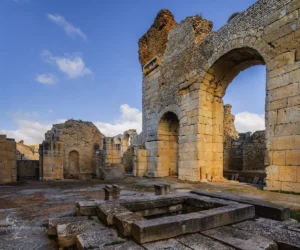The Ancient Town of Maktar: A Journey Through Time Maktar, a town in Tunisia, boasts a rich tapestry of history. Founded by the Berber Numidians, it served as a defensive outpost against Carthaginian expansion. When the Romans destroyed Carthage in 146 BC, many Punic refugees settled in Maktar. This influx of people significantly shaped the…
Berber People (Amazigh)
The Berber people, also known as the Amazigh, are an indigenous ethnic group native to North Africa. With a history that dates back thousands of years, they have inhabited the region long before the arrival of Arab conquerors in the 7th century. The Berbers have a rich cultural heritage that is characterized by their own languages, social structures, and traditions. They predominantly reside in Morocco and Algeria, with smaller communities in Tunisia, Libya, Mali, and Egypt. Despite the Arab influence in North Africa, the Berbers have managed to preserve their identity, language, and culture over the centuries.
The Berber languages, collectively known as Tamazight, belong to the Afro-Asiatic language family. These languages have several dialects, reflecting the diversity among Berber communities across North Africa. In recent years, there has been a significant movement towards the revitalization and official recognition of the Berber languages. For instance, Morocco and Algeria have made Tamazight an official language alongside Arabic, marking a significant step in the preservation and promotion of Berber cultural identity.
Berber society is traditionally organized in tribes and clans, with a strong emphasis on family and community ties. The social structure is largely egalitarian, and leadership roles are often based on consensus or elected positions. Historically, the Berbers have been known for their skills in agriculture, craftsmanship, and trade. Their expertise in weaving, pottery, and metalwork is highly regarded, and these crafts play an essential role in the cultural and economic life of Berber communities.
The Berbers have a rich tradition of music, dance, and oral literature, which plays a crucial role in the preservation of their cultural identity. Traditional Berber music often features a combination of vocal and instrumental performances, with instruments such as the bendir (frame drum), the oud (lute), and the flute being particularly prominent. Festivals and social gatherings are important cultural events where music and dance are performed, serving both as entertainment and as a means of passing down traditions and stories from one generation to the next.
Religion has also played a significant role in the lives of the Berber people. Initially practicing indigenous beliefs, the majority of Berbers gradually converted to Islam following the Arab conquests. However, they have managed to retain some of their pre-Islamic customs and rituals, which have been integrated into their Islamic practices. This syncretism is a testament to the Berbers’ ability to adapt and incorporate external influences while maintaining their unique cultural identity.
Today, the Berber people continue to navigate the challenges of modernity while striving to preserve their heritage. They face issues such as cultural assimilation, language endangerment, and economic marginalization. However, through education, political activism, and cultural revival initiatives, the Berbers are actively working towards greater recognition and autonomy within the North African region. Their enduring legacy is a reminder of the resilience and richness of indigenous cultures in the face of changing global landscapes.
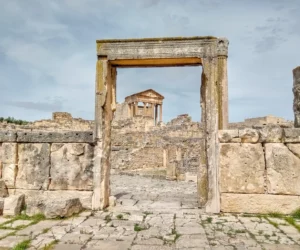
Dougga
Discovering Dougga: A Journey Through Time Dougga, also known as Thugga or TBGG, stands as a testament to the rich tapestry of civilizations that have flourished in northern Tunisia. Nestled near modern-day Téboursouk, Dougga is a remarkable archaeological site spanning 65 hectares (160 acres). Recognized by UNESCO as a World Heritage Site in 1997, Dougga…
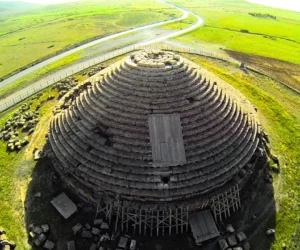
Madghacen
Discovering Madghacen: A Numidian Jewel Madghacen, also known as Imedɣasen, is a royal mausoleum-temple of the Berber Numidian Kings. This grand structure stands near Batna city in Aurasius Mons, Numidia, Algeria. The site reflects the rich history and architectural prowess of ancient North Africa. Architectural Marvel The Numidian kingdom, though independent, engaged in Mediterranean power…
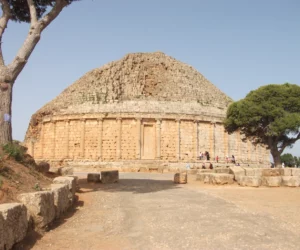
Royal Mausoleum of Mauretania
The Royal Mausoleum of Mauretania: A Monument to Ancient Sovereignty Located on the road between Cherchell and Algiers in Tipaza Province, Algeria, the Royal Mausoleum of Mauretania is a testament to ancient architectural brilliance. This funerary monument is the resting place of Numidian Berber King Juba II and Queen Cleopatra Selene II. Their union linked…
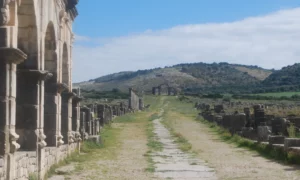
Volubilis
Volubilis, a partly-excavated city located near Meknes, Morocco, represents a significant archaeological site with roots stretching back to the 3rd century BC. Initially a Berber settlement, it later became a proto-Carthaginian city before serving as the capital of the Kingdom of Mauretania under King Juba II. The city’s strategic location in a fertile agricultural area facilitated its development and prosperity, particularly under Roman rule from the 1st century AD.
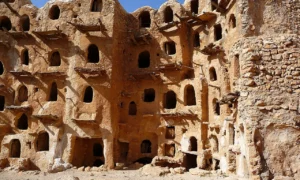
Kabaw
Kabaw is a historical site that captures the essence of ancient ingenuity and cultural significance. Nestled in the landscape of Libya, it stands as a testament to the architectural prowess and societal structures of the civilizations that once thrived in the region. This place, though not as widely recognized as other historical sites, offers a unique glimpse into the past, with its ruins and remnants telling stories of bygone eras.

